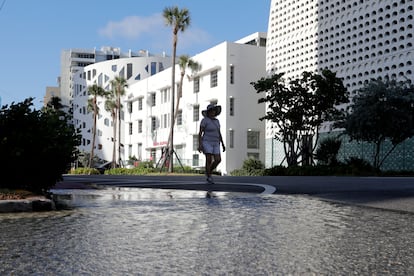When climate hits home
Climate change is becoming a systemic risk for the well-being of each of the planet’s inhabitants

Landowners, homeowners, and other owners of real estate properties are facing losses that could reach $25 trillion worldwide—a sum not far from the GDP of the United States— according to The Economist. This staggering figure underlines the vulnerability of real estate assets, the kind of assets typically purchased with borrowed money. The global credit market heavily relies on property as collateral. What happens to that market if the value of these real estate assets suddenly plummets? Such a scenario could trigger the most destabilizing shock the global economy has ever faced. And what might cause such an impact?
Climate change.
The effects of the climate crisis, though often unprecedented, have become routine. Not a week goes by without reports of devastating climate events from various corners of the globe. Similarly, we frequently receive updates based on the latest scientific findings about the speed, magnitude, and consequences of climate change.
Efforts to address the impacts of the climate crisis are slow, inadequate, and uncoordinated. Worse still, effective responses often fail to capture the attention of those who could help make a difference.
Recently, I was invited to speak to a group of real estate professionals in Miami. I asked them if their clients were concerned about the potential impact of climate change on their expensive properties. None said that this was the case. It’s just an anecdote, but a telling one.
The disconnect between scientific predictions of the rapidly rising impacts of climate change and the decisions being made is a major source of systemic risk in the global economy. Capital markets are simply being slow to acknowledge facts that, to the scientific community, are indisputable. This misalignment between climate change alarms and inertial business as usual poses an unprecedented threat.
In Miami, climate risk is not theoretical. In a city where many high-rise buildings often have parking garages several floors below the building’s lobby, the consequences of water damage and the costs of relying on large pumps to relocate the water coming from a rising sea are already evident. They start with the higher costs of insuring a beachfront or lakefront property. In fact, many governments and large insurance companies have already alerted that properties close to the water are “uninsurable.” Recognizing the credit risk of these coastal properties, banks and other financial institutions have ramped up the interest rate they charge to the potential buyers of these assets.
One might think this would prompt reflection, but it doesn’t seem to. Barring a Karina-like hurricane that, for example, hits Miami instead of New Orleans is an event that will surely serve as the alarm that decision makers need to snap out of a business-as-usual mindset.
Miami is just one example of a global trend. The 11 million residents of Jakarta, Indonesia’s capital, face an unprecedented crisis as their coastal city sinks under its own weight while sea levels rise, forcing the government to build a costly new capital on the island of Borneo. This pattern repeats across the globe in cities like Osaka, Chicago, Kolkata, Rio de Janeiro, Lagos, and Dhaka, all facing catastrophic damages in the coming decades due to the changing climate.
In New York, infrastructure designed for a different climate, struggles to adapt to rising sea levels and more frequent, destructive storms and prolonged droughts. Conversely, in London, known for its fog and rain, recent droughts are causing the clay soils under the city to subside, damaging thousands of homes and buildings.
What we see now is just a glimpse of the economic damage climate change will cause in the decades ahead. There is no turning back: much of the global warming we will experience in the coming decades is what climate scientists call “committed warming,” driven by greenhouse gases that have already been emitted, but whose full effects will take decades to make themselves felt.
This isn’t about virtue-signaling or feel-good greenwashing; climate change is becoming a systemic risk to the well-being of every person on the planet.
We have known this for a long time. Yet it remains enormously challenging to respond in ways that reflect the scale of the crisis. When even real estate agents in Miami fail to grasp the magnitude of the situation, it’s clear that there is much work to be done to adapt to the hostile climate system we have created.
Sign up for our weekly newsletter to get more English-language news coverage from EL PAÍS USA Edition
Tu suscripción se está usando en otro dispositivo
¿Quieres añadir otro usuario a tu suscripción?
Si continúas leyendo en este dispositivo, no se podrá leer en el otro.
FlechaTu suscripción se está usando en otro dispositivo y solo puedes acceder a EL PAÍS desde un dispositivo a la vez.
Si quieres compartir tu cuenta, cambia tu suscripción a la modalidad Premium, así podrás añadir otro usuario. Cada uno accederá con su propia cuenta de email, lo que os permitirá personalizar vuestra experiencia en EL PAÍS.
¿Tienes una suscripción de empresa? Accede aquí para contratar más cuentas.
En el caso de no saber quién está usando tu cuenta, te recomendamos cambiar tu contraseña aquí.
Si decides continuar compartiendo tu cuenta, este mensaje se mostrará en tu dispositivo y en el de la otra persona que está usando tu cuenta de forma indefinida, afectando a tu experiencia de lectura. Puedes consultar aquí los términos y condiciones de la suscripción digital.











































